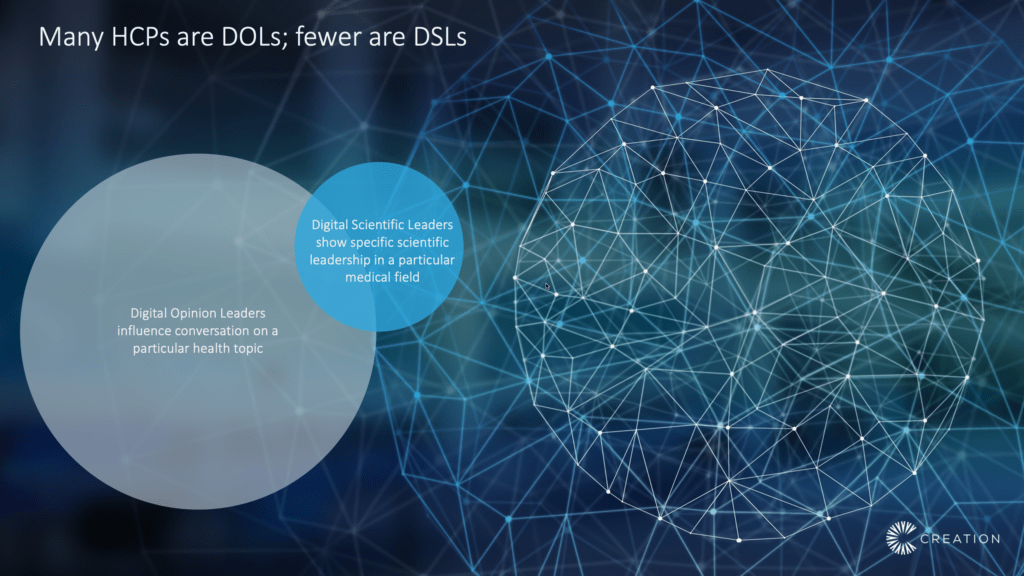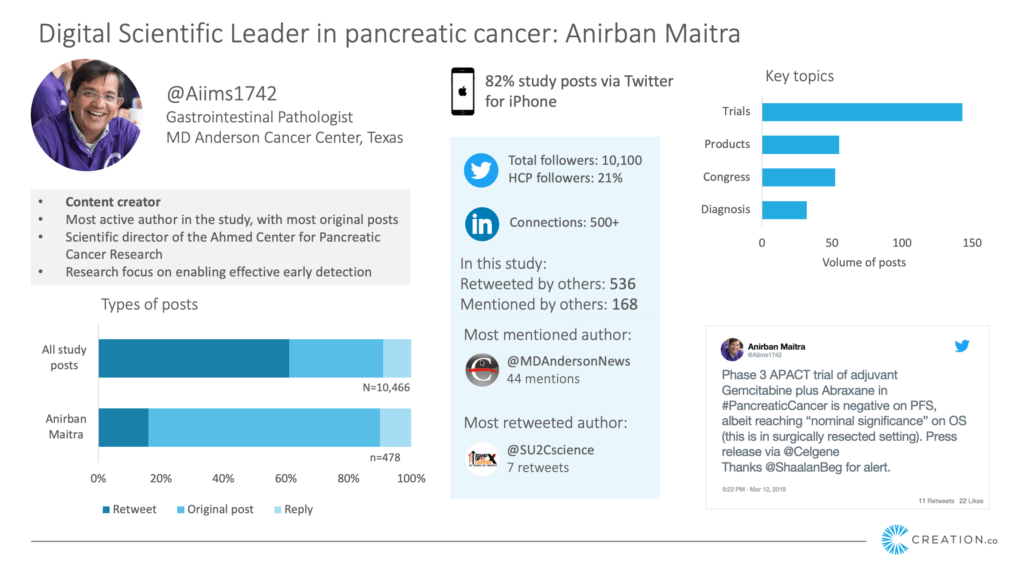Deloitte states that there is a distinct set of core capabilities that are essential across the Medical affairs to deliver value and impact across the organisation – Evidence Generation, Scientific Exchange and Stakeholder Management. The growth in digital has left a mark on all three capabilities, but the latter two have seen the greatest shift in the last decade and especially in the COVID-19 environment.
Over the last 20+ years in the healthcare industry, CREATION.co has seen a steady increase in healthcare professional (HCP) use of social media for professional purposes (which jumped by nearly 50% up in the year of the pandemic!) leading to the rise of the HCP Digital Opinion Leader.
Today, more and more medical teams are recognising the significance of social media when it comes to capturing the insights directly from customers and communicating the treatment value. Many DOLs have become the new KOLs, and teams have embarked on a journey to understand how to engage these thought leaders and how to leverage their influence online. Just recently we have completed a successful multi-market project in diabetes supporting a global medical team in learning from the digital therapy area landscape before launch and identifying the most influential online HCPs for future collaborations, education and building advocacy.
Working with many medical teams and exploring the challenges and opportunities in stakeholder management and scientific exchange, CREATION.co have identified three best practices when it comes to identifying and engaging the HCP thought leaders online.
- Start with the end goal in mind.
- Identify the right individuals.
- Context is key to determine online influence.
Start with the end goal in mind
The thought leader identification is only as effective as the end goal. In other words, having clear vision and objectives that align with the overall strategy for the organisation will determine the success of this exercise. It will shape the relationships you will develop with the identified thought leaders and decide the impact they will have on your business.
Some example objectives from teams we have been working with recently included scientific or educational collaboration in order to reach primary care physicians by co-creating content, building early advocacy, using a DOLs’ voice online to reach patients, co-developing resources to correct misinformation or raise awareness of new treatment data, or simply making sure that the most influential HCPs online have up to date information on the product.
At CREATION.co, we commit to collaborating with the teams on defining your end goal and what you hope to achieve.
Some of the useful questions to answer as a team are:
- What challenge/opportunity are you looking to address by identifying DOLs?
- What do you need to know about these individuals in order to address the challenge/opportunity you are facing?
- What are the ways that you hope to engage these individuals once identified?
Identify the right individuals
Answering the questions above and similar ones will help you understand what kind of DOLs are right for you. Who are the HCPs that are “nice to have” and who are the absolutely necessary ones you need to know about? For example, a Digital Opinion Leader with a large public following and passionate for general disease awareness, but with little to no interest in the scientific conversation is a “nice to have” but might not be the right individual to consider for strategic partnerships around communicating the science behind the treatment.
DOLs suitable for marketing or commercial teams might look different to those suitable for the medical teams. CREATION.co have therefore identified a subset of Digital Opinion Leaders – Digital Scientific Leaders (DSLs). DSLs are HCPs who possess all the qualities of a DOL but have a specific focus and influence in the scientific conversation within the therapy area.

DSLs are driving the discussion around latest study and trial data, testing and diagnosis and mechanism of action of treatments. In other words, they have a natural inclination to lead and shape the scientific dialogue amongst their peers online. They usually have higher scientific credentials and use their media for peer learning, education and collaboration.
Anirban Maitra is an example DSL from a public study we did looking at HCP opinions and behaviours in relation to pancreatic cancer online. Throughout the conversation he actively expressed his opinions on various trials discussing results with his peers. He kept his audience up to date with the latest trial results and his peers shared his content when seeking information. Anirban Maitra was the most shared HCP in the study.

While there is certainly a benefit in knowing about influential HCPs online even if they don’t fit your strategy or particular objectives, thought leader identification online can be a costly exercise and its impact needs to be measured. Therefore understanding the context is crucial.
Understand the context of DOL influence
The context of a DOLs’ or DSLs’ influence is a significant catalyst for successful engagement. Understanding the digital landscape and therapy area environment that your DOLs or DSLs operate in can provide you with insight into their needs. HCP thought leaders are part of a large online ecosystem. They only have influence because there is a need for something, whether that is advice, education, medical information or support. When that need resonates with the passion or an interest of an HCP, they start developing themselves as an opinion leader to address it.
Listening to what HCPs say online will enrich and inform your overall strategy, give you understanding of where your DOLs or DSLs fit within the therapy area dialogue and will help engage your customers in a meaningful way through their influence.
CREATION.co has been supporting top 10 pharmaceutical companies for over 20 years and has identified and profiled hundreds of influential HCPs, each with specific end goals and contexts in mind. We have helped countless teams find and build strategic collaborations with their top HCPs and can support you whether you are at the very start of your DOL and DSL journey or have become an expert.

 By Laura McIntyre
By Laura McIntyre 


